How To Test A Starter Solenoid – Step by Step Process
A starter solenoid works on a couple of very basic principles. Its main purpose is to transfer electric current from the battery towards the starter itself, hence the name. The solenoid is activated as soon as you turn the key.
This engages the electric motor located in the starter that then gets the engine up and running. If the starter does not work, then it is highly likely that your vehicle will not even start in the first place.
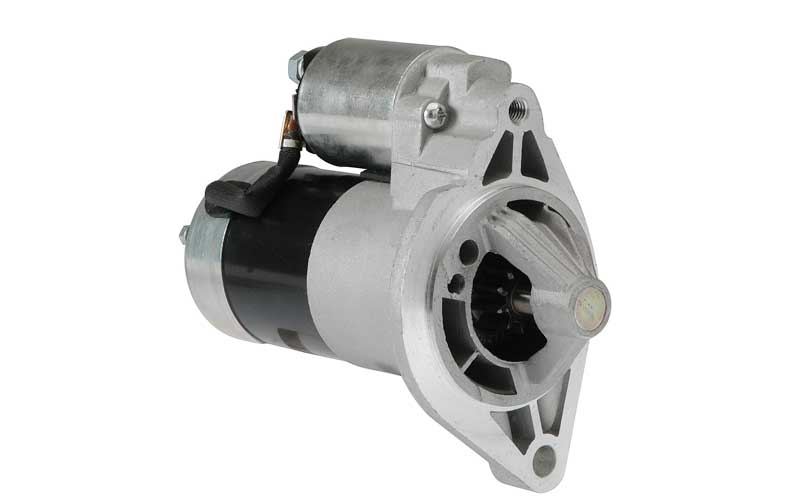
Therefore, if your vehicle is not starting or horsepower is fluctuating while it is on, the starter should be the first thing you need to check. Some car owners are skeptical of this.
However, this is not an overly complicated process, and you do not need to engage a professional/mechanic every time.
The following section contains a stepwise on how to test or check a starter solenoid. If you like to be prepared in such scenarios, then you will definitely want to give this a read.
Symptoms of a Faulty Starter Solenoid
As mentioned above, a starter works mainly off of the battery as its main source of power. The purpose of a starter is to start the engine of your car.
If there is something off with the starter, the starter solenoid, or the battery, your engine will not run properly, and your vehicle may not even start-up in the first place. This can be troublesome because your options will be fairly limited.
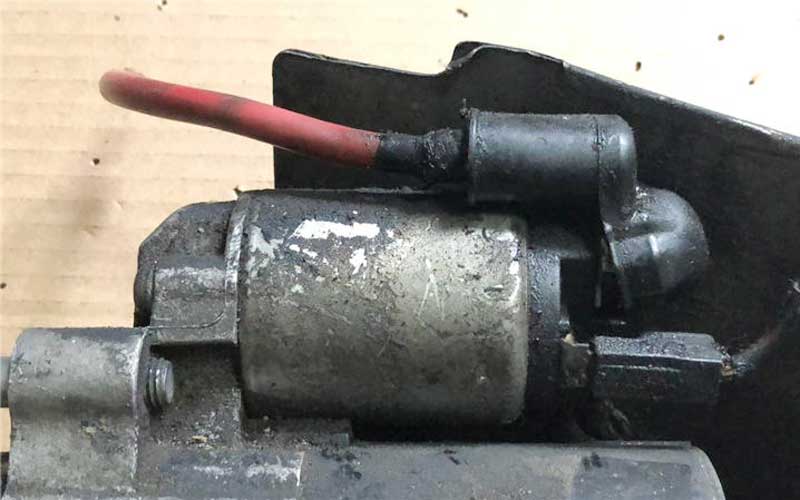
In order to spot a few telltale signs of a faulty starter or starter solenoid, read on to find out more.
- Learn to listen to the sounds that your vehicle makes. In this particular case, it is important that you observe the noises that are produced when you turn on your vehicle or turn it off. More specifically, you need to be vigilant when the key turns in the ignition at any point.
- You might come across some unusual clicking sounds, which are typically a warning sign for a faulty starter/solenoid. However, even if you don’t hear these noises, there is a small chance that these components may still be at fault.
- Another fairly obvious sign is that your car does not start. You might notice that your dashboard lights are on, but the engine does not crank up. This means that there is probably a problem with the starter.
- You can try to remedy the problem by attempting to jump-start your car. If this fails, then your suspicions will be confirmed. If you are at home, then contact your local garage or mechanic. If you are on a highway or on the road, then your best bet is to contact roadside assistance or similar authorities to give you a hand.
Part 1 – Steps to Locate the Starter Solenoid
- Pop open the hood of your vehicle. The starter, along with the solenoid, is situated in the engine compartment of the vehicle. In order to open the hood, press on the release latch and plug in the safety latch to keep it upright while you are working.
- In the event that you cannot find the safety latch or the hood release, you can consult the manual that comes with your vehicle because the location might be different depending on the model of the vehicle. The next step is to locate the starter. Typically, it is situated near the conjunction where the transmission lays over the engine.
- Usually, the starter is shaped like a cylinder with a smaller cylinder, similar to the starter, attached to it. Starters may come in all kinds of sizes; however, the shape is pretty consistent for the most part.
- If you look carefully, you will also notice a wire extending all the way from the battery’s positive terminal to the starter. If locating the starter is difficult for you, you can consult the manual for more information on what it looks like and where it is likely to be located.
- Now pinpoint the location of the smaller cylinder fitted next to the cylinder-shaped starter. This smaller cylinder is, in fact, the starter solenoid. The starter solenoid will likely be attached to the side of the top of the starter.
- The starter solenoid also has two different terminals coming out at either end. Similar to the starter, a wire from the battery is also connected to one of these terminals. Get somebody to help you with this next part. Ask your partner to put the key in the ignition and turn it.
- Meanwhile, listen to see if the solenoid clicks when the key is turned in the ignition. If you do not hear a click at all, then the starter solenoid is not working properly and is likely faulty. In addition, no clicking can also be an indicator that your vehicle’s battery is dead and needs to be recharged.
- If you do hear a click, but the vehicle does not start properly, that means that the starter solenoid is engaging to a certain extent but not enough to start the vehicle. To remedy this, first, check to see if the battery is charged. You can do this by using a voltmeter.
- Connect the voltmeter to the positive and negative terminals of the battery, respectively, and check for a reading. A low reading for voltage indicates that you should charge your battery.
- Otherwise, a reading of about twelve volts or higher means that the battery is good to go, and your vehicle should start in principle. By checking the battery, you can at least rule out the possibility that the battery is at fault, and focus on the starter solenoid.
Part 2 – How to Check for Current in the Starter Solenoid
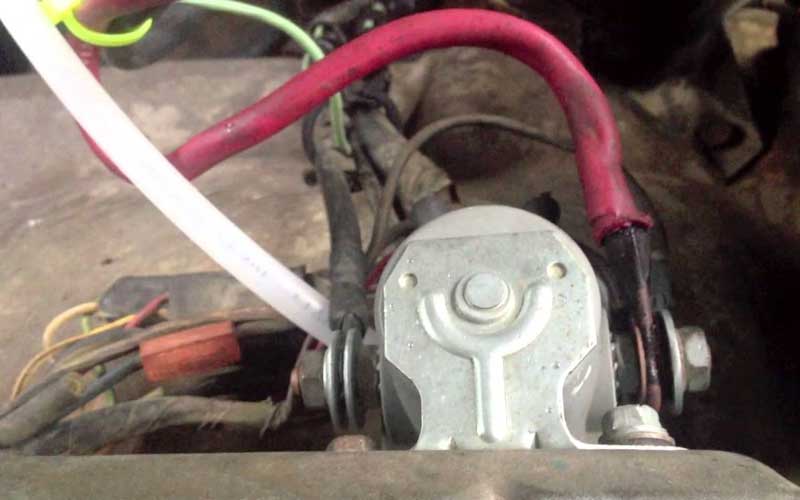
- In order to check if the starter solenoid is working properly, you can connect a test light to it. Locate the two input and output terminals present on the starter solenoid. Connect the test light to the output terminal as the other terminal is the one already connected to the battery.
- Once the starter solenoid is activated as such, it can internally connect both the terminals. Once this is done, hold the red lead on the test light fixed on the upper terminal of the starter solenoid.
- Take the black lead from the test light and earth/ground it such that the circuit is complete. You can use any part of the body of the vehicle to ground the black lead wire. The only condition is that it should be pure metal.
- Alternatively, you can also hold it in place atop the negative terminal of the battery, as well. Once the circuit is complete, only then it will be possible to gauge the amount of current passing through it.
- Now focus on the red lead wire, if it lights up then that indicates that there is current passing through to the solenoid via the battery. This means that the battery is working properly, but there is some internal fault in the starter solenoid itself.
- Once you are sure there is currently going through the wire, you have to check whether the starter solenoid is passing it forward or not. For this purpose, place the red lead to the lower terminal of the solenoid. Meanwhile, the black lead wire should be grounded the same as before. Have someone help you out and turn the key in the ignition once again.
- Ideally, this should cause the circuit to become complete and transmit electricity to the lower terminal of the starter solenoid. Be very careful to stay away from potentially moving components in the engine during this particular step.
- Now observe the test light once again. If it turns on, that means the solenoid is transmitting electric power from the battery towards the starter. If the starter does not activate despite the light turning on, you may need to replace it altogether because it is likely at fault.
- However, if the light does not turn on, there is something wrong with the solenoid as it is not transmitting electric power to the starter properly. In this case, the solenoid will need to be replaced. You can easily find both these components from your local auto parts shop. Therefore, you should have no trouble finding replacements for both if needed.
- For these components, it is important that you get the starter and solenoid that will actually fit in your vehicle. You can consult a manual for this or your local mechanic for further information regarding the specifics.
Final Thoughts
Now that you have this guide in your back pocket, you will have no trouble taking charge of the situation when it comes to testing your starter solenoid. There is a select number of steps for this process, and they are easy to follow for beginners as well. As you can see, the process is not that complicated after all, best of luck!
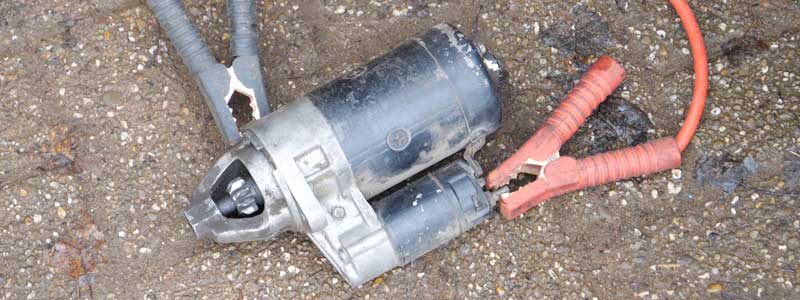

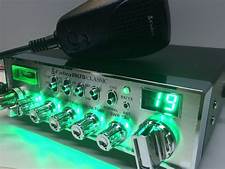



Post Comment